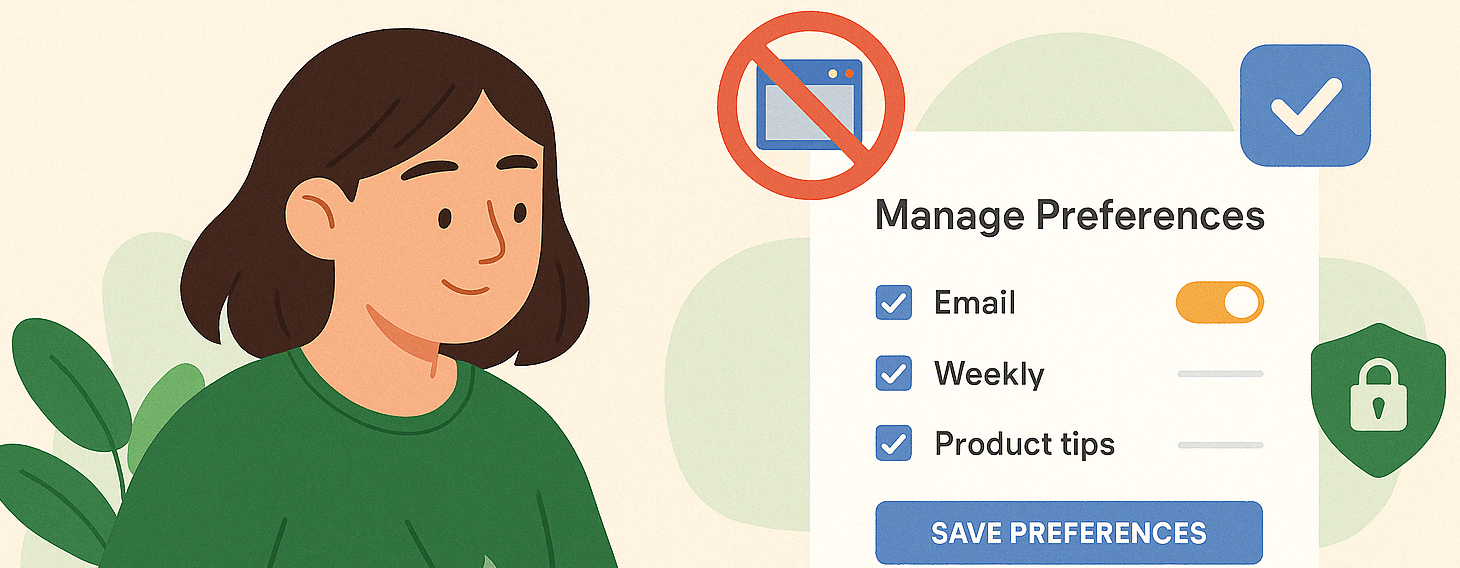Table of Contents
Ever feel like you’re clicking “Accept” on cookie banners without even thinking? You’re not alone.
Today, we’re overwhelmed with pop-ups, from subscription prompts to privacy notices, before we’ve even seen what the website offers. That constant friction has led to a real issue: consent fatigue. It’s not just annoying, it’s affecting trust. And it’s time brands stopped treating user experience like a compliance checkbox.
This article explores a better way: respecting users through thoughtful design, starting with tools like preference centers. And if you’re running an ecommerce store, that means rethinking how (and when) you ask for attention – because even a 1% lift in email engagement or opt-in rate can translate into real revenue.
Key Takeaways
- Bombarding users with consent requests, email popups, and tracking banners leads to disengagement and reflexive opt-outs, not loyalty.
- People are more likely to stay subscribed when they feel in charge of how and when you communicate.
- Instead of forcing choices upfront, preference centers invite users into a relationship, one based on transparency, relevance and respect.
- You don’t need a full platform overhaul. A clean page, clear language, and frequency controls can significantly improve engagement.
- Every “manage preferences” link, every update option, every respectful opt-in flow tells your customers: you matter to us. That’s how modern brands grow.
The Burnout Behind the Clicks
We’ve all been there.
You open a website and before you’ve even seen the product, you’re hit with a cookie notice, then a newsletter pop-up, followed by a discount code prompt. You haven’t even scrolled.
What started as a way to personalize the web has turned into a digital interrogation room.
This is popup fatigue – and its close cousin, consent fatigue – and it’s quietly draining your customer’s patience. People are tired of being asked to agree, subscribe, opt-in, opt-out, “accept all” or “manage preferences” before they even know if your brand is worth their time.
It’s not just annoying, it’s a trust breaker. And in ecommerce, that means abandoned carts, skipped signups, and rising unsubscribe rates.
In a 2024 Scientific Reports study, researchers found that repetitive privacy prompts cause decision avoidance and lower satisfaction. Users begin to click reflexively, not mindfully, or they bounce altogether.
And here’s where it gets worse: brands often respond by doubling down. More urgent popups. Sooner in the session. Bigger discounts. But the real result? You just feel louder, not more helpful.
According to Optimove’s 2025 Marketing Fatigue Report, 70% of users unsubscribed from at least one brand in the last 90 days because of too many messages.
So what’s the alternative? How do you ask for consent or invite engagement without becoming another brand users want to silence?
Let’s shift gears and see how preference centers give that power back to your users and build trust while you’re at it.
Rethinking the Ask: The Preference Center
Instead of ambushing your audience with demands, what if you just… gave them space?
That’s the quiet power of a preference center. No pressure, no interruptions, just a page where your customers can say, “Here’s how I’d like to hear from you.” It’s consent on their terms and that makes all the difference.
What a Preference Center Really Does
A good preference center is a relationship builder, not simply a compliance tool. It lets people:
- Choose how often they want updates
- Select what kind of content they care about (sales? stories? tutorials?)
- Pick their channel: email, SMS, push, none
- See in plain language what data you collect and why
And the best ones don’t stop there. They sync seamlessly with your broader tech stack – platforms like Klaviyo, Shopify, and Omnisend – to ensure user preferences are respected across all touchpoints, in real time.
This isn’t about hiding settings in the footer but moving from forced consent to informed choice.
And when brands do it well? Users don’t just tolerate it, they appreciate it. Salesforce’s “State of the Connected Customer” report found that 80% of customers say the experience a company provides is as important as the product itself.
Turns out, how you ask is just as important as what you sell.
Who’s Doing It Right?
You don’t need to be a tech giant to offer a clean, respectful preference flow. Here are a few brands that standout:
- Sephora gives users full control of email types and frequency, from beauty tips to VIP deals.
- ASOS includes real-time “manage preferences” links in every email, not buried in the fine print.
- Allbirds uses humor: their unsubscribe flow includes playful, lighthearted language for a softer downgrade path.
The common thread? Clarity, control, and tone that feels human, not corporate.
Available studies show that brands using transparent preference centers see higher opt-in rates and lower unsubscribes than those relying solely on pop-up prompts.
In short, the best experience isn’t always the fastest or flashiest. It’s the one that makes your customer feel seen, respected, and in control. In ecommerce, that can translate directly into higher AOV and better retention. It’s not just about saving face but growing value.
Ready to build one that actually works?
Building a Preference Center That Actually Respects People
So, you’re on board with moving past popups. You want to give customers control, not just collect checkboxes. Now what?
A preference center isn’t just a settings page. Done right, it’s a living, breathing part of your customer experience. One that builds loyalty every time someone opens an email, clicks a notification, or chooses to stay.
Let’s talk about how to get it right.
1. Keep It Simple But Not Shallow
The most common mistake? Making it look like a legal form. People don’t want to decode policy-speak. They want to click a few boxes and move on. Therefore, your preference center should be:
- Visually clean and mobile-friendly
- Grouped by meaningful categories (e.g., “New product launches,” “Only big promos,” “Tips & how-tos”)
- Free of hidden defaults or pre-checked options
Don’t just show email frequency, describe what each option feels like. For example:
- “Monthly highlights – best stuff, no fluff.”
- “Weekly deals – hot drops + discounts.”
The tone matters as much as the layout. You’re not writing a contract. You’re extending an invitation.
2. Let Users Choose Their Own Frequency
Not everyone wants to hear from you three times a week. In fact, many will unsubscribe not because they don’t like you, but because it’s just too much.
A simple toggle “Once a week / Once a month / Only for major updates” gives users control and prevents fatigue.
And here’s the best part: people who customize are way more likely to stick around.
3. Show What You Know (and Let Them Edit It)
A great preference center doesn’t simply manage communications but also shows transparency. Let users see:
- What info you collected
- How it’s being used
- What they’ve opted into and when
Then give them one-click control to change it. Bonus points if it updates in real time across your CRM and ESP (this is where integration with platforms like Klaviyo or Iterable comes in handy).
4. Don’t Make It a Dead End
This isn’t just a settings panel, it’s part of the journey. So don’t design it like a box-checking chore. You can:
- Use it to introduce new features or message types
- Drop in helpful links (“See our latest updates” or “What’s coming next”)
- Suggest recommended settings based on behavior
Make the experience feel proactive, not passive – like you’re helping them get the most out of the brand, not just avoiding spam.
5. Test It Like a Product Page
If you wouldn’t launch a landing page without testing copy, CTA placement, and clicks… don’t treat your preference center any differently.
A/B test:
- Wording of categories
- Layout and mobile UX
- Exit behavior: does the user stay engaged or bounce?
Then tie it to real metrics:
That’s how you turn your preference center from a form into a feature.
Common Roadblocks (and How to Get Past Them)
So you’re sold on building a better preference center but maybe your tech stack isn’t playing nice. Or maybe your boss is worried it’ll tank email signups. Or maybe you’ve got three tools, five teams, and no one really “owns” the customer journey.
Totally normal. Let’s unpack a few of the biggest hurdles and how to handle them without losing momentum.
1. “Our Systems Don’t Talk to Each Other”
This one’s common: your marketing platform, CRM, and subscription tool all live in different worlds. It’s hard to offer users one clean place to manage their preferences when your backend looks like a spaghetti map.
What you can do:
- Start with a simple public-facing page. Even a basic form that connects to one source of truth is better than nothing.
- Use tools like Klaviyo, Segment, or HubSpot that support unified preference management.
- Work with what you’ve got: even just syncing email frequency and content type preferences is a strong start.
Don’t let “perfect integration” delay the rollout. Your users don’t need fancy, they need clarity.
2. “Won’t This Hurt Our Signup or Send Volume?”
Here’s the thing: it might reduce the raw number of people you blast, but it will almost always increase the quality of those relationships.
People who feel in control:
- Open more emails
- Click more links
- Stay subscribed longer
- Buy again
Unsubscribes and spam reports tank your sender reputation. Giving users an off-ramp (or “slow down” option) keeps your list clean and your brand trusted.
So yes, you might email fewer people. But you’ll email better people.
3. “No One Owns This Internally”
This is a real issue, especially in mid-market or siloed orgs.
Preference centers sit in a weird spot between product, marketing, legal, and CX, which often means… no one owns them.
Try this:
- Make it a CX initiative first, not just a compliance fix.
- Pitch it as a retention tool, not a cost center.
- If needed, start with a cross-functional “Experience Taskforce” – one rep from each core team – and give it a clear 90-day goal: ship something functional, then iterate.
Ownership doesn’t need to be perfect, just accountable.
4. “We Don’t Have Time Right Now”
Let’s be honest – building a new preference center probably isn’t at the top of your backlog. With product launches, campaigns, bugs, and quarterly targets, it’s easy to push this kind of initiative into the “someday” pile.
That’s totally fair, yet this isn’t a “later” thing. It’s a compounding trust builder and one of the few touchpoints that quietly affects everything from retention to deliverability to how customers talk about your brand.
Here’s a low-lift version you can ship in a sprint:
- A clean landing page with checkboxes for email preferences
- A clear unsubscribe button/unsubscribe flow
- Copy that explains how/when you’ll contact the user – an honest explanation of what users are opting into
- A follow-up confirmation email that feels personal (one that feels written by a human, not written by a legal team)
The good news? You don’t have to tackle it all at once. Start with something small, test it, and build from there. The impact will grow, and so will your customer’s trust in the way you handle communication.
Conclusion: What Happens When You Stop Interrupting?
Here’s the simple truth: people don’t hate marketing, they hate being cornered by it. Popup fatigue, endless consent prompts, and generic opt-ins are signals that a brand isn’t listening, not simply some UX annoyances. When every inbox is crowded and attention is fragile, how you ask matters just as much as what you say.
This is why preference centers are a statement, a quiet but powerful way to say “We respect your time. We trust you to decide.” And that shift from grabbing to inviting, from pushing to empowering is what separates brands people tolerate from the ones they truly trust.
No, it won’t happen overnight. You’ll need to rethink a few defaults. Maybe give up some send volume. But what you gain in return – loyalty, clarity, better data, and a real relationship with your audience – is worth every click you didn’t force. Because in the end, the best marketing doesn’t demand attention, it earns it.
Want to make sure your setup actually works? Run through this before you go live:
- Is it mobile-friendly?
- Can users choose both content type and email frequency?
- Is the tone human, not robotic?
- Do users see what data is collected (and how it’s used)?
- Can they update preferences with one click?
- Is it integrated with your email/SMS platform?
- Do you track changes in opt-in behavior?
If you checked at least five of these, you’re well ahead of most brands still relying on “accept all” banners and batch-and-blast emails.


































 Christina Sol
Christina Sol 




 Greg Raileanu
Greg Raileanu 